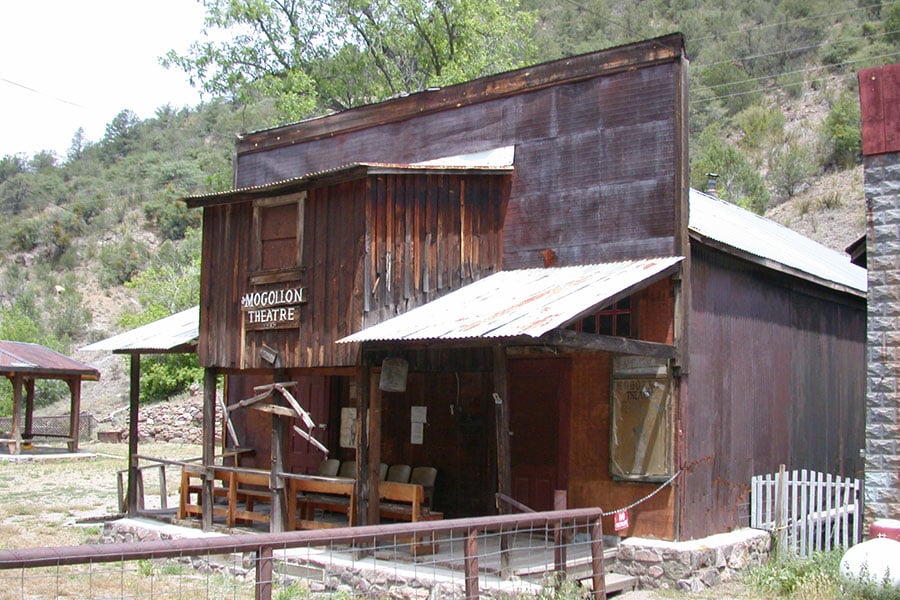
There is a certain mystique to New Mexico ghost towns. As you stroll through one, you can almost hear the conversations that once happened. You can almost see the people bustling by on the now quiet streets. You may even get a hint of the taste of moonshine served at the local watering hole.
Some people estimate that New Mexico has over 400 ghost towns. The towns sprung up as men tried to get rich while searching for gold, silver, turquoise, and copper. Others were built as farming communities. Others still were only used temporarily as the railroad was built to span the country or built around railroad stations. Over the years, many have been reduced to only a few foundations of buildings that once stood tall against the landscape. Some have survived weather and time and are intriguing time capsules into a time long ago. If you visit one, please remember that quite a few are still inhabited and the residents ask for privacy.
All of the following ghost towns are close to Silver City, New Mexico, and the Gila National Forest. Stay with our Silver City area member Casitas de Gila Guesthouses and learn more about these testaments to history.
Mogollon: sits at 6,500 feet above sea level among the mountains of the Gila National Forest. The isolation led to it becoming one of the wildest towns of the west. It has the infamous reputation of once being the headquarters for Butch Cassidy and his men. Mining was still active here until the 1950s and resumed briefly in the 1970s. The 1 ¼ mile hike up to the graveyard gives a real perspective of what the town once was as you pass shacks and decaying artifacts. The headstones in the graveyard tell the stories of men who died in the mines and families lost to the Spanish Flu. As you head back towards town, take a moment to look down the canyon for an idea of how the town once looked. A few people still live here year-round. Visitors on the weekends from May to October are treated to an art gallery, mining museum, antique store, and cafe. (Also pictured above: Mogollon Theatre)
Steins: is an example of a railroad ghost town. In the late 1800s, around 1,000 Chinese workers lived in the area as the Southern Pacific Railroad developed a quarry in the nearby bluffs. When the railway was completed in 1880 a station was built and a small town grew up around it. This town saw its share of notorious folks when the Black Jack Ketchum Gang tried to rob a train there. A trainman died in the scuffle and the gang got away, but with nothing to show for their efforts. The early population in the area had a difficult time with no local water source. Instead, water came in via train. After World War II, the Southern Pacific Railroad discontinued the stop leaving the townspeople without water. Thankfully for those still there, the railroad offered them transportation to wherever they wished to go and the town was abandoned. Throughout the years, different owners have attempted to renovate the town, however, it is currently closed to visitors.
Steins, New Mexico Photo by Alton Woods licensed under the Creative Commons 2.0 License.
Shakespeare: began as a town called Mexican Springs. It was a stop along the Butterfield Overland Stage line. Interest in the area grew in 1870 when silver ore was located in the surrounding hills. The town grew rapidly to 3,000 people and, when the silver quickly ran out, rumors began about diamonds being found in another nearby area. Within a couple of years, the truth that the diamonds were planted became evident and people left town just as quickly as they had arrived. It was renamed to Shakespeare to avoid its dirty history and was lucky enough to see a second silver boom. This luck was also short lived when the town was abandoned after the depression in 1893. The town is now a privately-owned National Historic Site. Tours are offered one weekend a month and living history re-enactments are held several times a year.
Hillsboro: was founded by two prospectors who discovered gold in the Black Range Mountains. Tents were quickly replaced by adobe and wooden structures. Within three years, the town had four saloons, four grocery stores, and a post office. Founded in 1877, it is still a very lived-in town full of ranchers, writers, and artists. The historic ambiance lives on in the “downtown” area. Stop by the Black Range Museum when you visit this town or plan a trip around their popular Apple Festival.
